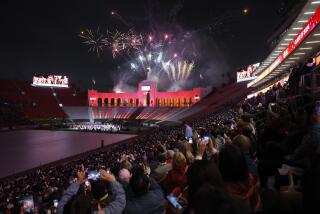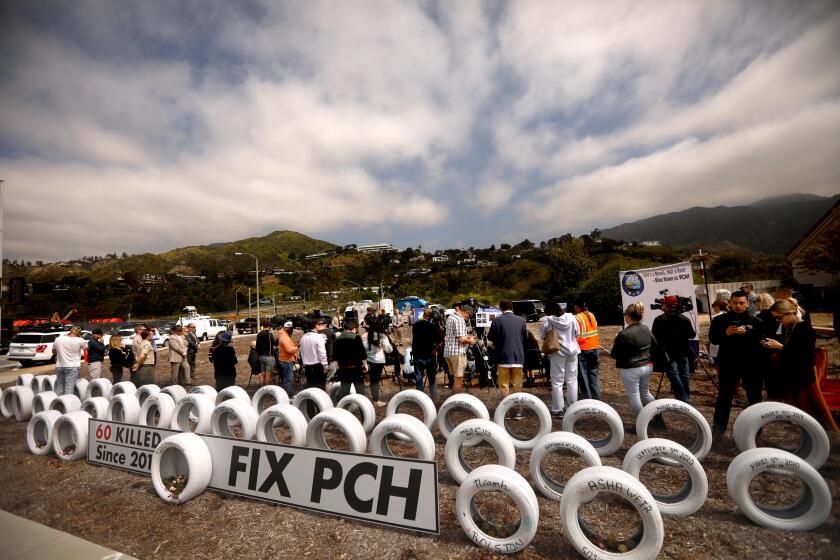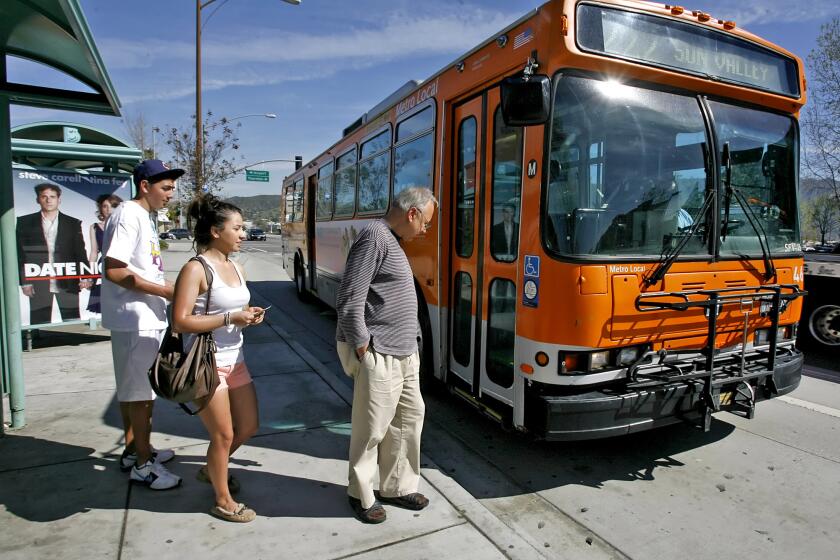Irvine Hopes to Lead Conversion in Defense Firms : Policy: The city wants to be the national model in shifting Pentagon contractors toward the civilian sector. A monorail project could be the first step.
Irvine Mayor Larry Agran, never one to take a modest view of the role of local government, is once again plunging into a simmering national political debate. This time, the issue is “economic conversion,” the technocratic code-phrase for beating swords into plowshares.
Agran wants to make Irvine a national model for how a defense-oriented economy can be shifted toward civilian endeavors. Unlike many of the peace groups that have long preached the conversion gospel, Agran has an idea of how to do it: He wants to use the city’s proposed $250-million monorail project to create a local mass-transportation industry that would utilize the talents of soon-to-be-underworked defense companies.
“It’s clear we’re going to be dealing with a new set of priorities, and this is an excellent place to begin,” Agran said. “We would like to see the design and construction (of the monorail) done locally, and hopefully we will then have learned enough to be a center of excellence in transportation.”
Agran suggests that 70% of the contracts for the transport project, whose funding depends on the passage of Proposition 116 next month, be earmarked for firms in Irvine or the surrounding area. His proposed Irvine Institute for Entrepreneurial Development would also look for ways to nudge local rocket scientists toward environmental cleanup, health care and other such enterprises.
Unfortunately, defense contractors have shown a remarkable inability to make large-scale moves into new businesses, and several of their worst failures have involved mass transportation. Many experts say the culture of defense contracting is inimical to civilian production and nearly impossible to change.
Although communities around the country have turned abandoned military bases to productive use, and some have even transformed defunct factories, the Irvine proposal is far more ambitious. If the plan succeeds, the city will likely be the first government anywhere to transform its local defense industry. If it fails, Irvine could end up with some very overpriced monorail trains and not much else.
There is little consensus, in Irvine or nationally, about the need for a policy on economic conversion. A smaller defense budget has long been a priority for groups such as the National Council for Economic Conversion and Disarmament. Now that such cutbacks are taking place, the debate has shifted to whether government can or should manage the transition to take advantage of a skilled labor pool and preserve jobs.
Some tiny programs already exist. The Pentagon’s Office of Economic Adjustment, with a paltry budget of $3.5 million, provides technical assistance and grants to communities trying to adapt to changes in military spending.
The state of Washington has established a similar program to assist defense-dependent communities, although its initial budget is a meager $200,000. Some state governments have helped communities on a case-by-case basis. But the push for economic conversion legislation at all levels of government is just beginning.
Representative Ted Weiss (D-New York) is pushing legislation that would require defense contractors to establish labor/management “alternative use” committees to study new market possibilities. It also would mandate extensive retraining of defense workers.
On the state level, Assemblyman Sam Farr (D-Carmel) is promoting a package of bills that would require the governor to convene an “economic summit” on conversion, appoint a council to study the issue and come up with a means of facilitating the transfer of military technology to the civilian sector.
Other states are considering laws to require at least the study of the conversion issue, but California’s effort is especially significant because the Pentagon will spend about $55 billion in the state this year, according to the Commission on State Finance.
In Los Angeles, Councilwoman Ruth Galanter, with the support of the International Assn. of Machinists, is convening a committee to study prospects for establishing an electric car-manufacturing industry in the Southland.
“This will create jobs that were formerly in aerospace,” said Lou Kiefer of the machinists union. “There are linkages in the technologies and the skills involved in aerospace and electric cars.”
The Irvine proposal stands out, however, because the monorail funds could provide a fulcrum for a government-guided effort to shift defense manufacturing facilities to civilian production.
Initially conceived as a demonstration project to show the feasibility of suburban monorails, the system will consist of a four-mile loop through the Irvine Business Center, plus a high-speed link connecting the loop to the new transportation center in the Irvine Spectrum and the countywide monorail system that has been widely discussed in recent months.
Irvine, seeking to add to its national reputation as an innovator in community planning and environmental protection, has secured a commitment for $125 million in matching funds under Proposition 116, a ballot proposal authorizing $1.9 billion in bond funds for rail transit projects statewide. Agran expects the city, the county and developers to pony up the $125 million necessary to gain access to the bond money.
Agran raised the idea of using the monorail as a local industrial policy tool at a conference that he convened on the economic conversion issue in February.
Irvine, with only one major defense manufacturer--the 3,000-employee Parker Bertea Aerospace--actually is less dependent on military contracts than other Orange County cities such as Fullerton or Huntington Beach, which have huge defense installations.
The leverage provided by the prospect of $250 million in transit funds is critical to Agran’s economic conversion project, since some local defense industry executives are skeptical of the concept.
“I don’t see that government--whether it’s national, state or local--has much to bring to the party,” said James E. Lowes, group vice president for Parker Bertea. “It’s something industry has to do for themselves.”
Lowes said it is unrealistic to expect a company to build “airplanes today and roads tomorrow.”
In the same vein, Jerry L. Cobb, director of marketing operations for McDonnell Douglas Space Systems Co. in Huntington Beach, said he would “hate to see a major initiative to try and convert aerospace into plowshares. We’re best off staying with the things we know best.”
That caution is spurred in part by the failure of conversion efforts by Rohr Industries and Boeing-Vertol. Chula Vista-based Rohr, seeking new business as Vietnam War expenditures began to decline in the late 1960s, won contracts to build subway cars and control systems for the Bay Area Rapid Transit in San Francisco and the Washington Metro.
But both systems experienced huge cost overruns and technical failures, in part because the Rohr technology was overly complex and difficult to manage.
Similarly, Boeing’s Vertol subsidiary near Philadelphia was looking for a way to replace helicopter orders when it decided to enter the streetcar business in the early 1970s. But as Columbia University industrial engineer and economic conversion apostle Seymour Melman details in his 1983 book, “Profits Without Production,” the company’s adaptation of military production methods to a civilian business resulted in sleek, sophisticated cars that were unsuited to the daily grind of a metropolitan transit system.
“Military and NASA contractors have a culture in which you think of profit as a function of the costs you incur,” said John E. McDonald, chairman of PDA Engineering in Costa Mesa, which has successfully converted from military contracting to commercial software.
Many government contracts are “cost-plus,” meaning a contractor is paid for his costs plus a certain profit percentage, he noted. Thus, the higher the costs, the higher the profit.
“In civilian production, it’s just the opposite; costs and revenues are independent variables,” he continued. On a competitive contract, a company gets a fixed amount of money. The lower the costs, the higher the profit. “That form of thinking doesn’t exist in the defense industry.”
McDonald acknowledged that many defense contracts are now subject to competitive bidding but said that has made little impact on corporate cultures. “It’s a competition between people who all do business the same way. Pitting Lockheed against Boeing doesn’t change the fundamental problems with aerospace.”
Melman emphasized that any conversion effort must emphasize retraining of workers and managers. “You can’t just go to one of these firms and say, ‘You have 1,000 people here, so instead of making something for the military, make something for cities.’ You need a complete technical and economic redesign of the company.”
Melman doubts a city such as Irvine has the capacity to assure that kind of make-over. Without it, he said, Irvine will end up with “a solid-gold monorail system that doesn’t work. It’s happened before.”
Agran acknowledges the problem, but said: “It’s not my responsibility to hold the hand of corporate executives. They would have to demonstrate to us that they could do it.”
He also seems unconcerned about the possibility that a “local content” requirement might push up the cost of the monorail. “It might cost a few extra dollars on the front end, but what it would generate would pay dividends for generations to come,” he said.
More to Read
Start your day right
Sign up for Essential California for news, features and recommendations from the L.A. Times and beyond in your inbox six days a week.
You may occasionally receive promotional content from the Los Angeles Times.






